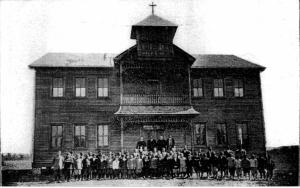Pictured above is the Saint Joseph’s Industrial School for Colored Boys at Opelousas. The school was established through the efforts of Father John Engerbrink and the beneficence of Saint Katharine Drexel.
The Reverend Father John Engerbrink, an energetic young Dutchman labored for nearly a quarter-century among the large congregation of Creole and Cajun families in Opelousas. Father Engerbrink expressed a great interest in providing educational opportunities for his colored parishioners. He secured the help of Saint Katharine Drexel and recruited Leonard Dwight Lang to establish an industrial school for boys in Opelousas.
In 1900, the Josephite Fathers had opened Saint Joseph’s College for Negro Catechists at Montgomery, Alabama. The school was intended to offer colored young men what might be called equivalent to a high school and normal course, industrial arts training, and catechetical instruction. These men were to return to their communities with a sound educational basis and a good understanding of the Faith. Among the early graduates of the school was Leonard Dwight Lang. “L. D.” as he was usually called had been born in Key West, Florida in 1888 to parents who were both of West Indian extraction. His father, Joseph Lang, was a cigarmaker and was employed by the Custom House at Key West. Lang joined the faculty of the College after graduating, and became prefect in 1908. While at the College, he became acquainted with both Saint Katharine Drexel, great benefactress of Colored and Indian missions, and with Professor Booker T. Washington, founder of the great Tuskegee Institute.
In 1911, Professor L. D. Lang opened Saint Joseph’s Industrial School for Colored Boys. The site on which the school was built was purchased by Saint Katharine from members of the Donatto Family. His early collaborator in conducting the school was a native of Opelousas, Dewey Benjamin Donatto (who later became a successful dentist in Opelousas). In April 1914, Archbishop James Blenk of New Orleans traveled to Opelousas to dedicate the newly-built edifice shown in the photograph. Professor Lang encouraged older boys who had a firm grasp on their lessons to help instruct the younger boys. The school continued until 1920 when Father Hyland, the pastor of the then newly-erected Holy Ghost Parish, combined the existing girls and boys schools into one parochial school. L. D. Lang moved to Natchez, Mississippi where he spent the rest of his life.
Among the more well-known former pupils of the school were Father Carmen George Chachere, S.V.D. and Father Earl Lawrence Chachere, M.S.S.T., brothers, and descendants of two of Saint Landry Parish’s earliest families.
J.C.L.H.




Interesting reading. I am a descendant of the Lang family and still reside in KeyWest